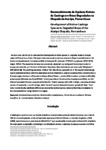Use este identificador para citar ou linkar para este item:
http://www.alice.cnptia.embrapa.br/alice/handle/doc/1018230Registro completo de metadados
| Campo DC | Valor | Idioma |
|---|---|---|
| dc.contributor.author | DRUMOND, M. A. | pt_BR |
| dc.contributor.author | RIBASKI, J. | pt_BR |
| dc.contributor.author | FARIA, S. M. de | pt_BR |
| dc.contributor.author | OLIVEIRA, V. R. de | pt_BR |
| dc.contributor.author | SA, I. B. | pt_BR |
| dc.contributor.author | PEREIRA, P. S. | pt_BR |
| dc.contributor.author | SANTOS, D. E. P. de S. | pt_BR |
| dc.date.accessioned | 2015-06-22T11:11:11Z | pt_BR |
| dc.date.available | 2015-06-22T11:11:11Z | pt_BR |
| dc.date.created | 2015-06-22 | pt_BR |
| dc.date.issued | 2015 | pt_BR |
| dc.identifier.citation | In: SIMPÓSIO DE MUDANÇAS CLIMÁTICAS E DESERTIFICAÇÃO NO SEMIÁRIDO BRASILEIRO, 4., 2015, Petrolina. Experiências e oportunidades para o desenvolvimento. Petrolina: Embrapa Semiárido, 2015. | pt_BR |
| dc.identifier.uri | http://www.alice.cnptia.embrapa.br/alice/handle/doc/1018230 | pt_BR |
| dc.description | This work was carried out to evaluate the development of native species in degraded areas in Araripe region of Pernambuco State. The experiment was established in an area of an Experimental Station of the Instituto Agronômico de Pernambuco (IPA) in Araripina-PE. (Latitude: 7°27'50"S, Longitude: 40°24'38"W, height: 828m). The experimental area was previously subjected to plowing and harrowing in order to incorporate into the soil 2.0 t ha-1 of dolomitic limestone. Base fertilization was done with 100 g hole-1 NPK (10:80:30). The planting was done in hills of 30 x 30 x 30 cm, spaced 4 x 4 m. The experimental design was in randomized blocks with five replications and six treatments: angico [Anadenanthera colubrina (Vell.) Brenan], angico de bezerro [Piptadenia obligua (Pers.) Macbr.], aroeira [Myracroduon urundeuva Allemão], jurema preta [Mimosa tenuiflora (Willd.) Poiret.], pau d'arco [Handroanthus impetiginosus (Mart. ex DC.) Mattos] and sabiá (Mimosa caesalpiniifolia Benth.). ?Sabiá? species, with 1.68 m height, overcame all other species at twenty-four months of age, while ?aroeira? species showed the lowest growth (0.34m). There were no statistically significant differences among the studied species, showing that they are adapted to the environment for being native to the region. | pt_BR |
| dc.format | CD-ROM. | pt_BR |
| dc.language.iso | por | pt_BR |
| dc.relation.ispartofseries | (Embrapa Semiárido. Documentos, 262). | pt_BR |
| dc.rights | openAccess | pt_BR |
| dc.subject | Myracroduon urundeuva | pt_BR |
| dc.subject | Caesalpiniifolia | pt_BR |
| dc.subject | Piptadenia obligua | pt_BR |
| dc.title | Desenvolvimento de espécies nativas da Caatinga em áreas degradadas na Chapada do Araripe, Pernambuco. | pt_BR |
| dc.type | Artigo em anais e proceedings | pt_BR |
| dc.date.updated | 2016-02-15T11:11:11Z | pt_BR |
| dc.subject.thesagro | Caatinga | pt_BR |
| dc.subject.thesagro | Espécie Nativa | pt_BR |
| dc.subject.nalthesaurus | Anadenanthera colubrina | pt_BR |
| dc.subject.nalthesaurus | Mimosa tenuiflora | pt_BR |
| dc.subject.nalthesaurus | Handroanthus impetiginosus | pt_BR |
| dc.format.extent2 | 6 p. | pt_BR |
| riaa.ainfo.id | 1018230 | pt_BR |
| riaa.ainfo.lastupdate | 2016-02-15 | pt_BR |
| dc.contributor.institution | MARCOS ANTONIO DRUMOND, CPATSA; JORGE RIBASKI, CNPF; SERGIO MIANA DE FARIA, CNPAB; VISELDO RIBEIRO DE OLIVEIRA, CPATSA; IEDO BEZERRA SA, CPATSA; Pedro Silvino Pereira, Mestrando da Universidade Federal de Campina Grande; Dayana Evelin Pinheiro de Souza Santos, Estudante da Universidade de Pernambuco. | pt_BR |
| Aparece nas coleções: | Artigo em anais de congresso (CNPF)  | |
Arquivos associados a este item:
| Arquivo | Descrição | Tamanho | Formato | |
|---|---|---|---|---|
| 2015J.RibaskiSMCDSBDesenvolvimento.pdf | 562,51 kB | Adobe PDF |  Visualizar/Abrir |









